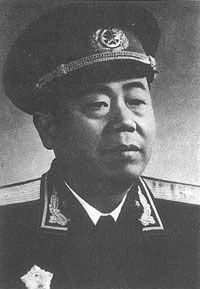Nie Fengzhi (simplified Chinese: 聂凤智; traditional Chinese: 聶鳳智; pinyin: Niè Fèngzhì; 7 September 1913 – 3 April 1992) was a general of the People's Liberation Army Air Force (PLAAF) of the People's Republic of China.
Nie Fengzhi | |
|---|---|
 | |
| Native name | 聂凤智 |
| Born | September 7, 1913 Dawu County, Hubei, Republic of China |
| Died | April 3, 1992 (aged 78) Nanjing, Jiangsu, China |
| Allegiance | |
| Service/ | |
| Rank | |
| Commands held |
|
| Battles/wars | |
Biography edit
Nie was born in Dawu County, Hubei in 1913[1] or 1914.[2] He belonged to the dominant Han ethnic group.[2]
Nie served in the People's Liberation Army (PLA) from 1929 until his retirement.[2] He was involved in founding the PLAAF,[2] and commanded the PLA's first aerial unit, the 4th Mixed Aviation Brigade, which was established on 19 June 1950 in Nanjing and consisted of 155 aircraft in one attack, one bomber, and two fighter regiments.[3][4] He attained the rank of lieutenant general in 1955.[1]
Korean War edit
In 1951, following China's entry into the Korean War, Nie commanded the East China Military Region Air Force and the People's Volunteer Army's short-lived Bomber Command at Dongfeng in Jilin province.[5] After Liu Zhen returned to China in July 1952, Nie commanded the PLAAF in Korea.[6]
Taiwan Strait Crises edit
At the time of the First Taiwan Strait Crisis, Nie commanded the East China (Huadong) Air Force.[7][8] During the Crisis, he served as vice-commander of the Zhejiang Front Command (ZFC)—established in 1954 by order of Mao Zedong and led by Zhang Aiping—and commanded the ZFC air force. He was one of the architects of the campaign to capture the Dachen Islands from the Republic of China. During a meeting of the ZFC commanders on 31 August 1954, Nie opposed the "majority opinion" favoring an immediate amphibious invasion of Dachen, and instead supported the "limited piecemeal tactics" proposed by Zhang. The resulting "Zhang-Nie plan" involved a focus on Yijiangshan Island, north of Dachen, and led to the Battle of Yijiangshan Islands in January 1955. During the course of the campaign, Nie personally spoke with every PLA pilot participating in operations in order to convey the order issued by the Central Military Commission to avoid direct confrontation with American air forces.[7][9]
During the Second Taiwan Strait Crisis in 1958, Nie served as commander of the Fujian Front Command air force.[10]
Nanjing Military Region edit
From 1975 to 1977, Nie served as Deputy Commander of the PLA's Nanjing Military Region and was a member of the Standing Committee of the Party Committee of the Nanjing Military Region CPC.[2] He became the Commander of the military region and Secretary of the Standing Committee in 1977, and remained in these posts until 1982.[2] He was also a member of the 11th Central Committee of the Communist Party of China, which was in session from 1977 to 1982.[2]
Death edit
Selected publications edit
- Nie Fengzhi; et al. (1985). Sanjun huige zhan Donghai [Three services wield weapons in East China Sea combat] (in Chinese). Beijing: PLA Press.[11]
- Nie Fengzhi. Zhanchang: jiangjun de yaolan (in Chinese).[11]
- Nie Fengzhi. "Coordination with Army and Navy forces during the liberation of Yijiangshan Island". Lantian Zhi Lu. 2.[11]
References edit
Citations edit
- ^ a b c "Lieutenant General - Nie Fengzhi". China Military Online. Archived from the original on 25 October 2009. Retrieved 10 March 2010.
- ^ "Chronicle of Major Developments in Chinese Aeronautics". Chinaculture.org. Archived from the original on 18 June 2009. Retrieved 22 March 2010.
- ^ Xiaoming 2003a, pp. 46–47.
- ^ Xiaoming 2003a, p. 103.
- ^ Xiaoming 2003a, p. 176.
- ^ a b Shu Guang 1992, p. 218: "General Nie Fengzhi, then air force commander of the East China Military region, recalls ordering his pilots not to engage any U.S. planes without express and prior approval from the Zhedong Front Command headquarters."
- ^ Xiaoming 2003, pp. 270–300.
- ^ Xiaobing 2003, p. 152.
- ^ Xiaobing 2003, p. 159.
- ^ a b c Xiaoming 2003, p. 297.
Works cited edit
- Ryan, Mark A; Finkelstein, David Michael; McDevitt, Michael A, eds. (2003). Chinese Warfighting: The PLA Experience Since 1949. Armonk, New York: M.E. Sharpe. ISBN 978-0-7656-1088-1.
- Xiaoming, Zhang. "Air Combat for the People's Republic: The People's Liberation Army Air Force in Action, 1949–1969". In Ryan, Finkelstein & McDevitt (2003), pp. 270–300.
- Xiaobing, Li. "PLA Attacks and Amphibious Operations During the Taiwan Strait Crises of 1945–55 and 1958". In Ryan, Finkelstein & McDevitt (2003), pp. 143–172.
- Shu Guang, Zhang (1992). Deterrence and strategic culture: Chinese-American confrontations, 1949–1958. Ithaca, New York: Cornell University Press. ISBN 978-0-8014-2751-0.
- Xiaoming, Zhang (2003a). Red Wings Over the Yalu: China, the Soviet Union, and the Air War in Korea. College Station, Texas: Texas A&M University Press. ISBN 978-1-58544-340-6.